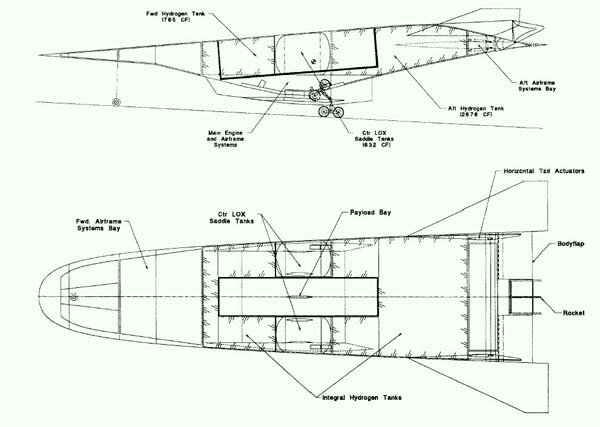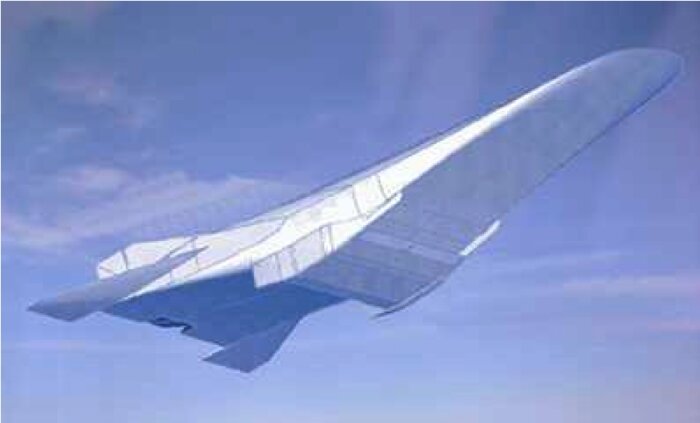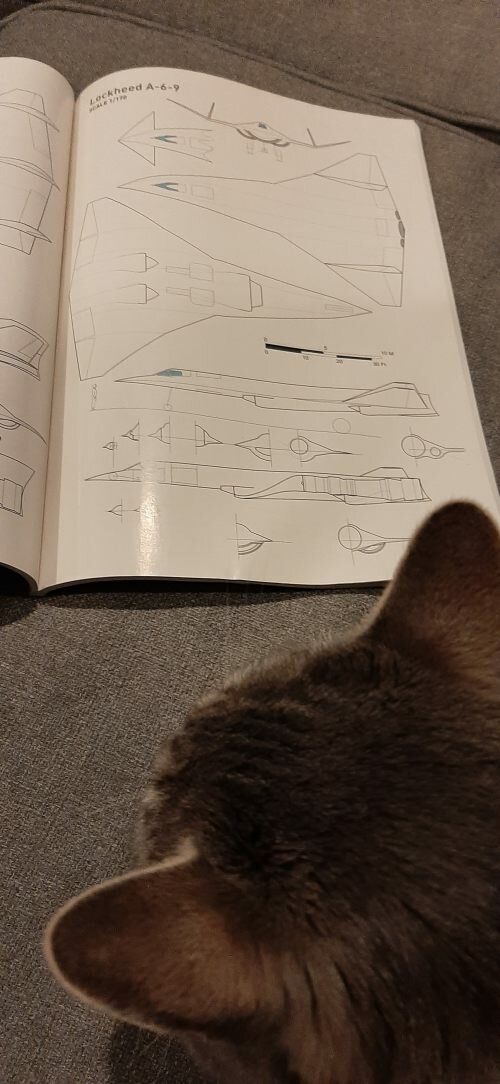You are using an out of date browser. It may not display this or other websites correctly.
You should upgrade or use an alternative browser.
You should upgrade or use an alternative browser.
Lockheed SR-71 Blackbird - Origins & Evolution
- Thread starter Orionblamblam
- Start date
- Joined
- 27 December 2005
- Messages
- 17,672
- Reaction score
- 25,775
Nice catNo, just well designed for the time. By the way, that was the first iteration of the diagram, from well over a decade ago; here's what it looks like in the book:This guy must have time travelled.
View attachment 675805
Forest Green
ACCESS: Above Top Secret
- Joined
- 11 June 2019
- Messages
- 9,283
- Reaction score
- 16,813
It reminded me of some NGAD illustrations.
Nice cat
That's the mean one.
Something I've wanted to tackle, but the references I've found have been either distressingly low-rez or irritatingly contradictory. Decent diagrams *were* made back in the day, but sadly I've not come across good enough quality copies to hope to produce reliably accurate diagrams of my own.(Now, among my top priorities, i am only short of quality 3-views of ... the Aerocon Wingship...
Got that. Used it to dig our FOIA requests. Not holding my breath on success, though.
(Now, among my top priorities, i am only short of quality 3-views of the ...the Aerocon Wingship,
What the hell, I started work using the references on hand. Some inconsistencies in the original diagram, coupled with the monumentally low rez, leading to some uncertainties. But it seems to be coming together.
Attachments
TheRejectionist
ACCESS: Secret
- Joined
- 2 February 2022
- Messages
- 237
- Reaction score
- 63
Question @Orionblamblam but IF remember correctly, aren't MOST of Lockheed products considered overrated and prone to malfunction or similiar issue?
Note : I am severely ignorant on the subject.
Note : I am severely ignorant on the subject.
Question @Orionblamblam but IF remember correctly, aren't MOST of Lockheed products considered overrated and prone to malfunction or similiar issue?
Lockheed products in the last several generations have tended to be technologically advanced, sometimes more advanced than entirely practical. F-22, F-35, AH-56 even F-104 were at the leading edge and had inevitable problems as a result. However, the F-104, SR-71, F-117 and others ended up being useful aircraft that put in decades of service.
Forest Green
ACCESS: Above Top Secret
- Joined
- 11 June 2019
- Messages
- 9,283
- Reaction score
- 16,813
Okay, now I'm trying to find out what an expander cycle turbojet is. All I can find is expander cycle rockets. Are they the same thing? And is there a difference between an ejector ramjet and a ducted rocket? Similarly air turborocket vs air turboramjet?
Last edited:
foiling
ACCESS: Secret
- Joined
- 12 August 2007
- Messages
- 367
- Reaction score
- 136
Thanks fo sharing this link. I know the illustrations, but hope eventually to see much better. I am confident that i will; there is so much talent on this site.Something I've wanted to tackle, but the references I've found have been either distressingly low-rez or irritatingly contradictory. Decent diagrams *were* made back in the day, but sadly I've not come across good enough quality copies to hope to produce reliably accurate diagrams of my own.(Now, among my top priorities, i am only short of quality 3-views of ... the Aerocon Wingship...
- Joined
- 21 January 2015
- Messages
- 12,042
- Reaction score
- 16,091
I thought that was you at first. I thought we had a hyper intelligent cat on the forum.Nice cat
That's the mean one.
Forest Green
ACCESS: Above Top Secret
- Joined
- 11 June 2019
- Messages
- 9,283
- Reaction score
- 16,813
A good read but more photographs would have made it better.
Scott, did you know this was coming???

 www.thedrive.com
www.thedrive.com

SR-71 Blackbird’s Predecessor Looked Even Cooler With Canards
An early design of the SR-71's predecessor had massive canard foreplanes. This is what it would've looked like if it had flown.
Photographs would ahve made it prohobitively expensive. Besides, not a lot of photos available that haven;t already been published. The diagrams, though... those were largely new to the public.A good read but more photographs would have made it better.
Yup, for a while now. Was supposed to be out a while ago, but Certain Events popped up in late February that caused them some distractions, I believe.Scott, did you know this was coming???

SR-71 Blackbird’s Predecessor Looked Even Cooler With Canards
An early design of the SR-71's predecessor had massive canard foreplanes. This is what it would've looked like if it had flown.www.thedrive.com
- Joined
- 27 December 2005
- Messages
- 17,672
- Reaction score
- 25,775
Sometimes the companies concerned will waive any costs for photographs with a no-fee reproduction agreement. I've seen one of those. It tends to help if you are a former employee, or good friends with relevant people inside the company, or if the book helps promote the company in a positive light.Photographs would ahve made it prohobitively expensive. Besides, not a lot of photos available that haven;t already been published. The diagrams, though... those were largely new to the public.A good read but more photographs would have made it better.
Sometimes the companies concerned will waive any costs for photographs with a no-fee reproduction agreement. I've seen one of those. It tends to help if you are a former employee, or good friends with relevant people inside the company, or if the book helps promote the company in a positive light.
That may all be true. But in the case of "SR-71," I had no photos that were really new or enlightening. Photos would have either had to replace text or diagrams, or expand the length of the book. I was unhappy with the first option, and the second option would have jacked up price for (in my opinion) no real added benefit. What I *would* have liked to have had is a bunch of brand new original color artwork depicting the various designs... but that would have not only had to involve the previously mentioned options of deletions or added pages, it would have also added substantial cost, as artists generally don't work for free for commercial products like this.
Speaking solely for myself: if I came across a book on the evolution and development of, say, the Lockheed SR-91 Aurora spyplane and it was full of photos that I've seen before, and at the same time I also find a similar history that was full of diagrams I hadn't seen before... so long as the diagrams are clear and trustworthy (unlike a *lot* of garbage books I've seen with craptacular low-rez drawings snagged from crappy online articles with no provenance and low trustworthiness), I'm buying the book with the diagrams. Every time. Maybe the photo book will sell better, I don't know... but that's not the book I want, either to buy or to create.
Granted, if I came across a photo album of SR-91 photos... sure, what the hell, I'll publish it, so long as doing so won't get my ass in a sling with the feds.
- Joined
- 27 December 2005
- Messages
- 17,672
- Reaction score
- 25,775
I agree, mostly. Picture-heavy books (e.g. 75 Years of the Lockheed Martin Skunk Works by Jim Goodall) generally leave me cold. The Secret Projects type books do benefit from desk model photos and a smattering of artwork to help visualise the designs better. Given the availability of material, there wasn't much alternative other than CGI which, like you say, is expensive.
- Joined
- 19 July 2016
- Messages
- 4,231
- Reaction score
- 3,409
I saw a copy of this book in Smith's yesterday, one of three on the shelf. I have seen a few books of this ytpe in Hasda be but they tend to be few and far between.
Forest Green
ACCESS: Above Top Secret
- Joined
- 11 June 2019
- Messages
- 9,283
- Reaction score
- 16,813
Are the combat radii in the back actually ranges?
Forest Green
ACCESS: Above Top Secret
- Joined
- 11 June 2019
- Messages
- 9,283
- Reaction score
- 16,813
Another question. The NASP 'Mach 25' scramjet. Can a scramjet really work at Mach 25, or was the idea to switch over to rocket power later?
Rhinocrates
ACCESS: Top Secret
- Joined
- 26 September 2006
- Messages
- 2,976
- Reaction score
- 7,529
Very unlikely IMO. My guess is that most of the imagery produced of even the later 'converged' NASP were equivalent to the initial B-2 illustrations that omitted the exhausts.Another question. The NASP 'Mach 25' scramjet. Can a scramjet really work at Mach 25, or was the idea to switch over to rocket power later?
Looking here,
Scroll down to Flateric's post at #15
NASA Langley, TDT Tunnell, November 1992 - NASP model is mutating again (if that really NASP-related).
Interesting, that later ARSLS (Advanced Reusable Small Launch System) craft looks pretty close to wind tunnel model.
ARSLS, even as a two-stage concept, has a linear aerospike rocket.

...and #34.
Actually, with the high level of probability, *this* is final X-30 configuration.
At least Pratt&Whitney paper authors state so.
Again, this looks like it has a rocket, suggested by the complication in the trailing edge.

No scramjet has worked past Mach 10, I believe. And even if you *could* get an airbreathing engine to work at Mach 25... it would be fundamentally insane to do so. At Mach 25, you want to spend as little time as humanly possible in the air. Because that nonsense will turn your plane into a shower of molten droplets.Another question. The NASP 'Mach 25' scramjet. Can a scramjet really work at Mach 25, or was the idea to switch over to rocket power later?
What you probably want to do is get to Mach ~10 in a climb, shoot out of the sensible atmosphere, and fire up that linear aerospike rocket engine in the tail to push you to orbit.
- Joined
- 5 May 2007
- Messages
- 1,448
- Reaction score
- 2,757
Assuming you can sustain Mach 10 at 110,000 feet, or thereabouts, that's enough kinetic energy to zoom up to over 1,600 km. Yes, switching to SI units when it becomes astronautics.What you probably want to do is get to Mach ~10 in a climb, shoot out of the sensible atmosphere, and fire up that linear aerospike rocket engine in the tail to push you to orbit.
I don't know how high up you get before the scramjet runs out of oxygen, but it'll be a heck of a difference to the performance needed of the rocket. Especially since you're now going to be lighting the thing as close to vacuum as makes no difference.
Don't forget that as height is increased, the Scramjet would need more air hence more speed to find enough oxygen to sustain a combustion. So, there is certainly something like a corner stone with Scramjet propulsion that would force you to switch to rocket propulsion anyway.
Forest Green
ACCESS: Above Top Secret
- Joined
- 11 June 2019
- Messages
- 9,283
- Reaction score
- 16,813
Wasn't there some article going around saying there's an engine that can work at Mach 16 now though? Sodramjet?
blackkite
Don't laugh, don't cry, don't even curse, but.....
- Joined
- 31 May 2007
- Messages
- 8,784
- Reaction score
- 7,579
Similar threads
-
Lockheed SR-71/YF-12 Blackbirds (Dennis R. Jenkins)
- Started by overscan (PaulMM)
- Replies: 3
-
-
SR-71: The Complete Illustrated History of the Blackbird by Richard H. Graham
- Started by F-14D
- Replies: 2
-
-
Convair Advanced Designs II: Secret Fighters, Attack Aircraft, and Unique Concep
- Started by jstar
- Replies: 29




